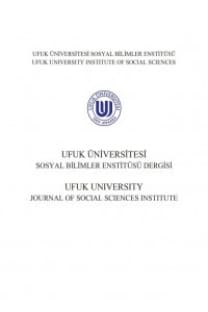AKADEMİK YAZMA DERSLERİNDE TEKNOLOJİNİN DÖNÜTE UYGULANMASI: EKRAN KAYDI İLE DÖNÜT VERME VE ÖĞRENCİ TUTUMLARI
akademik yazma, ekran kaydı ile dönüt, yazılı dönüt, sözlü dönüt
THE APPLICATION OF TECHNOLOGY TO FEEDBACK IN ACADEMIC WRITING CLASSES: THE USE OF SCREENCASTING FEEDBACK AND STUDENT ATTITUDES
academic writing, screencasting feedback, written feedback, oral feedback,
___
- Ali, A. D. (2016). Effectiveness of Using Screencast Feedback on EFL Students' Writing and Perception. English Language Teaching, 9(8), 106-121.
- Bellard, F. (2009). Screencast-O-Matic [computer software]. Retrieved from https://screencast- o-matic.com/
- Bitchener, J., & Knoch, U. (2009). The relative effectiveness of different types of direct written corrective feedback. System, 37(2), 322-329.
- Brick, B., & Holmes, J. (2008, October). Using screen capture software for student feedback: Towards a methodology. In Proceedings from IADIS 2008: International Conference on Cognition and Exploratory Learning in the Digital Age.Freiburg, Germany.
- Carr, A., & Ly, P. (2009). “More than words”: Screencasting as a reference tool. Reference Services Review, 37(4), 408-420.
- Egbert, J. (2005). CALL Essentials: Principles and Practice in CALL Classrooms. Alexandria, VA: TESOL, Inc.
- Ellis, R., Loewen, S., & Erlam, R. (2006). Implicit and explicit corrective feedback and the acquisition of L2 grammar. Studies in Second Language Acquisition, 28(2), 339-368.
- Ferris, D. (2003). Response to student writing. Mahwah, NJ: Lawrence Erlbaum.
- Ferris, D., & Roberts, B. (2001). Error feedback in L2 writing classes: How explicit does it need to be? Journal of Second Language Writing, 10(3), 161-184.
- Fraenkel, J. R.; Wallen, N. E. & Hyun, H. H. (2012) How to Design and Evaluate Research in Education. Eight edition, New York: Mac Graw Hill.
- Hamel, M. J., & Caws, C. (2010). Usability tests in CALL development: Pilot studies in the context of the dire autrement and francotoile projects. Calico Journal, 27(3), 491-504.
- Harper, F., Green, H., & Fernandez-Toro, M. (2012, September). Evaluating the integration of Jing® screencasts in feedback on written assignments. In 2012 15th International Conference on Interactive Collaborative Learning (ICL) (pp. 1-7). IEEE.
- Loch, B. & McLoughlin, C. (2011). An instructional design model for screencasting: Engaging students in self-regulated learning. In G. Williams, P. Statham, N. Brown & B. Cleland (Eds.), Changing Demands, Changing Directions. Proceedings Ascilite Hobart 2011, 816-821.
- Mathisen, P. (2012). Video feedback in higher education–A contribution to improving the quality of written feedback. Nordic Journal of Digital Literacy, 7(02), 97-113.
- NCTE Executive Committee. (2008). The NCTE definition of 21st century literacies. National Council of Teachers of English, 15.
- Park, K., & Kinginger, C. (2010). Writing/thinking in real time: Digital video and corpus query analysis. Language Learning & Technology, 14(3), 31-50.
- Séror, J. (2012). Show me Enhanced feedback through screencasting technology. TESL Canada Journal, 30(1), 104-116.
- Techsmith Corporation (2019). Jing [Computer Application]. Retrieved from https://www.techsmith.com/screen-capture.html
- Techsmith Corporation (2019). Camtasia [Computer Application]. Retrieved from https://www.techsmith.com/video-editor.html
- Telestream LLC (2019). Screenflow [Computer Application]. Retrieved from https://www.telestream.net/screenflow/
- Thompson, R., & Lee, M. J. (2012). Talking with students through screencasting: Experimentations with video feedback to improve student learning. The Journal of Interactive Technology and Pedagogy, 1(1), 1-16.
- Valeri, L. (2015). Screencasting for enhanced teaching and learning in blended and online creative writing classes. Writing & Pedagogy, 7(1), 153-174.
- Yök’ün “Yükseköğretimde Dijital Dönüşüm Projesi”nde İmzalar Atıldı. (2019, February 18). Retrieved from https://www.yok.gov.tr/Sayfalar/Haberler/agri-dijital-donusum- tanitim-toplantisi.aspx
- ISSN: 2146-7676
- Başlangıç: 2011
- Yayıncı: Ufuk Üniversitesi
MİLLİYETÇİLİK KURAMLARI VE TOPLUMSAL CİNSİYET: GENEL BİR DEĞERLENDİRME
Mehmet LÜLECİ, Coşkun İKİZLER, Güner KOÇ AYTEKİN
Türkiye’de Kayıt Dışı İstihdam ve Kayıt Dışı İstihdamla Mücadele Politikaları
Elif TOKDEMİR DEMİREL, Müge GÜNEŞ AKSU
VİX Korku Endeksi ve CDS Primlerinin Büyüme ve Döviz Kuruna Etkisi, Türkiye Örneği
Nil ÇAĞLAR BEKTAŞ, Şenol BABUŞCU
Farklılaşma ve Ayrışmanın Sosyolojisi: Tarihselliği Açısından “Kent Deneyimi”
TARTIŞMALI HAKLAR VE ÇEKİŞMELİ KONULAR: TÜRKİYE’DE BİLGİ EDİNME HAKKI ÜZERİNE BİR ÇALIŞMA
